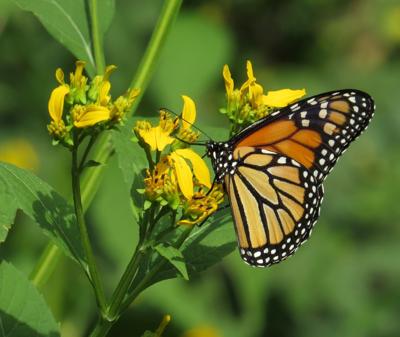©Marlene A. Condon
August 3, 2019

Yellow Crownbeard (Verbesina occidentalis) is a native “weed” that appeared in the author’s garden one year. It has been welcomed ever since because it feeds late-season Monarch butterflies. Courtesy Of Marlene A. Condon
You may think of August as another hot summer month, but for many kinds of critters, it heralds the coming of cold weather and the need to leave for warmer climes. Male Ruby-throated Hummingbirds usually disappear from feeders by the end of this month, and Monarch butterflies start to be seen more often in Virginia as they arrive from farther north.
These two species depend upon flowers for nectar and insects, which is why they are compelled to leave us. Very few plants bloom in winter and insects are, for the most part, not active.
Resident male hummingbirds leave first, followed within a week or so by adult females. Young birds of the year leave last. Most Ruby-throats spend the winter in southern Mexico and Central America, but with this season becoming somewhat warmer on average in recent decades, some hummingbirds are overwintering in states along the Gulf coast.
If you’ve been providing sugar water this summer, it’s a good idea to keep your feeder up throughout the fall. As flowering plants die or go dormant, there is less nectar available for hummingbirds still traveling south from more-northern states. They are sometimes seen as late as October in Virginia. Keeping your feeder out (filled with less sugar water since it won’t get many visitors) is a nice way to make the journey a bit easier for these tiny birds.
Some folks worry that a feeder will keep hummers from leaving, but that’s not the case. Animals that migrate do so when they are physically ready to undertake their long journey southward to escape cold and a dearth of food.
People have started to include milkweeds in their gardens to assist Monarch caterpillars. These plants are especially important throughout the fall months because Monarchs arriving from farther north are mating and laying eggs here. These adults will die, and their offspring will continue the southward journey towards Mexico where eastern U.S. Monarch butterflies overwinter.
If you wish to help Monarchs to reproduce well, the best plant to grow is Common Milkweed (Asclepias syriaca). This native plant grows to about four feet, on average, providing plenty of big leaves for caterpillars to munch on. Additionally, because the plant spreads by underground stems (called rhizomes), it often sends up new shoots late in the season, just in time for migrating Monarchs to lay their eggs where their caterpillars will have fresh green growth to eat.
Another way to assist Monarchs is to grow late-blooming plants that can furnish nectar for adults. Goldenrods (Solidago spp.) and the Common Dandelion (Taraxacum officinale) are perfect, and you may not need to purchase plants if you can leave a bit of bare ground where “weeds” can start to grow. Many of the plants people consider unwanted are not only exceedingly useful to wildlife, but also delightful for people to have in the garden. Goldenrods and dandelions create a sunny, warm glow when their golden and bright yellow blooms, respectively, appear as days are getting shorter and chillier.
